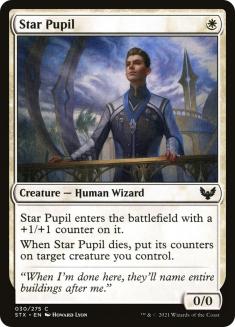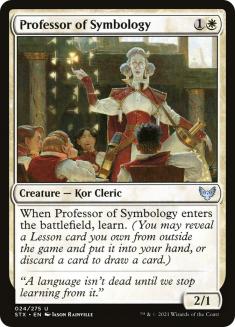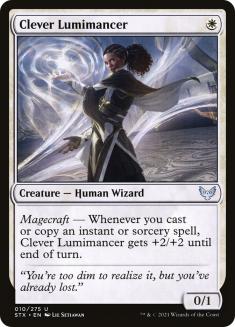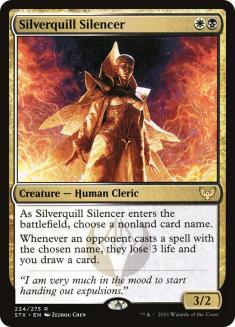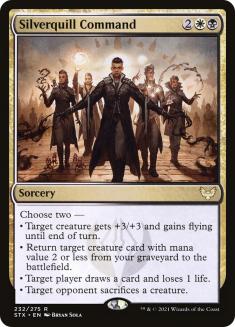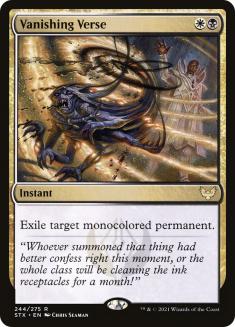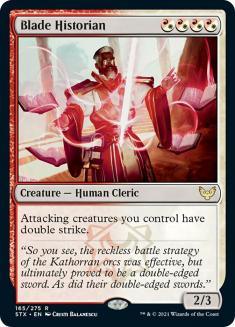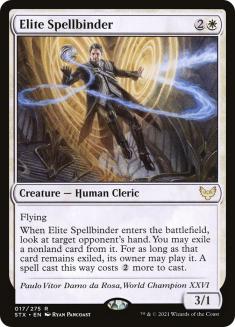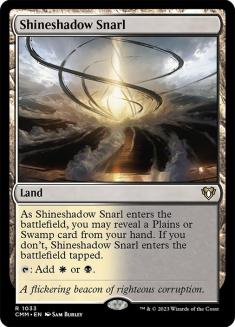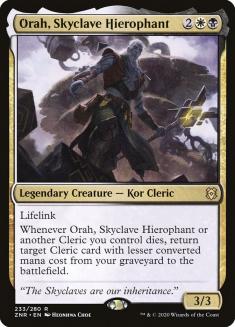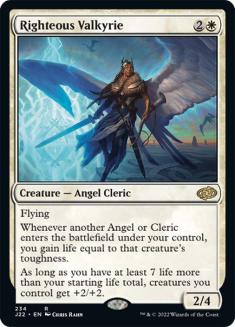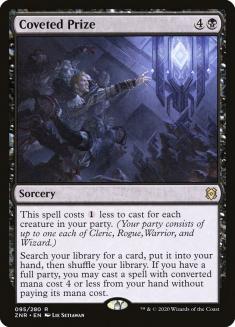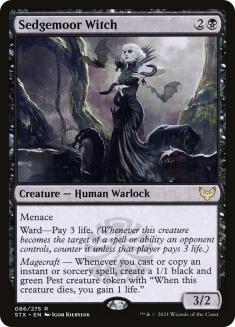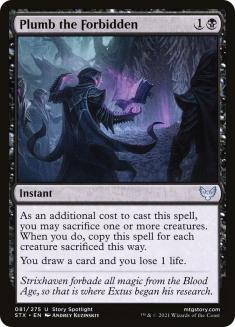Over the course of building decks during Strixhaven preview season, I kept coming back to white aggro decks. It’s not my normal area of expertise, although I’ve certainly had some success with similar decks. Of the cards I want to build around, the vast majority work well in white decks.
What does it take for a white aggressive deck to be successful in Standard? When Kaldheim was released, white picked up Usher of the Fallen; Reidane, God of the Worthy; and Faceless Haven, each of which helped skyrocket it into Tier 1 status. The answer seemed to be cheap threats, disruption, and resiliency, roughly in that order.
To that end, Elite Spellbinder is a massive boon. In a direct comparison to Reidane, God of the Worthy, Elite Spellbinder looks stronger in more situations. Silverquill Silencer is less impressive but it hits hard and can provide some value and reach.
Another card worth considering is Silverquill Command. It’s usually going to be a clean two-for-one, which is more than you’re getting from the other Commands. For four mana, it better be damn good though. There’s plenty of competition in the four-drop slot, so it won’t always make the cut.
Some of the other cards (like Star Pupil and Professor of Symbology) are role-players. You wouldn’t expect them to show up everywhere but they can be powerful if you build around them. Blade Historian is incredibly powerful. Red already has Torbran, Thane of Red Fell, so I won’t expect them to be dipping into Blade Historian anytime soon. Plus, you’d have to give up Faceless Haven, which red doesn’t want to do, especially when Torbran is already so similar.
In traditional Mono-White Aggro, I wouldn’t want to abandon Faceless Haven for Blade Historian either. A two-color deck can’t always support Faceless Haven, so that’s mainly where you’d want Blade Historian. Winota, Joiner of Forces is the obvious home for Blade Historian, but Paulo already covered that in-depth, so I won’t be discussing it here.
It shouldn’t be surprising due to the nature of the set, but the real winners from Strixhaven are the multicolored white aggro decks.
Creatures (32)
- 1 Heliod, Sun-Crowned
- 4 Alseid of Life's Bounty
- 3 Speaker of the Heavens
- 3 Orah, Skyclave Hierophant
- 2 Skyclave Apparition
- 3 Skyclave Cleric
- 4 Luminarch Aspirant
- 4 Righteous Valkyrie
- 4 Elite Spellbinder
- 4 Silverquill Silencer
Lands (22)
Spells (6)

With so many of the new cards being Clerics, building around them seems like a great place to start. Decks built around Orah, Skyclave Hierophant haven’t put up any noteworthy results but that isn’t necessarily Orah’s fault. It’s still a solid card but context matters. Purely trying to grind against any of the six best decks in Standard isn’t going to work out.
That said, using Orah as a way to maintain traction seems fine in general. In reality, that plan isn’t too dissimilar from using Basri’s Lieutenant, which also isn’t seeing much play. In most common matchups, you will benefit from cutting your four-drops, playing four Faceless Havens, and trying to win those games with aggression. The difference now is that Elite Spellbinder and being able to splash Duress mean you don’t necessarily need to win games as quickly as possible. It will take some games to actually figure that out though.
The other big difference from Orah’s release is that we didn’t have access to Righteous Valkyrie. It’s a Cleric, another Cleric reward, and probably what we should be building around more so than Orah. Granted, the new Clerics have low toughness, but you can use the one-drop lifelinkers with Luminarch Aspirant to quickly get over the threshold. We can also weave Skyclave Cleric into the manabase, which should get you there in most circumstances. With Righteous Valkyrie winning most of the creature matchups and Duress and Elite Spellbinder slowing down Sultai Ramp (Yorion), what’s not to like?
Vanishing Verse has very little downside. Now we have a clean answer to Embercleave; Anax, Hardened in the Forge; Goldspan Dragon; and almost everything else. Maybe you want to split your Vanishing Verses with Heartless Acts to kill Winota, Blade Historian, or Galazeth Prismari, but there’s very little it won’t hit.
The Snarls already have several issues and not working well with DFCs or Castles is yet another that doesn’t seem obvious until you start building decks with them. Snarls do help your manabase and you will play them in two-color decks, even if they come at a cost.
I would love it if we could play Blood Crypt, Unclaimed Territory, or something similar to act as a Swamp that could also cast Blade Historian. It would probably be worse than Orah but at least we’d have the option.
Aside from Winota, the other excellent home for Blade Historian is, oddly, in a lifegain deck.
My list is slightly different from the one in Bryan Gottlieb’s article last week.
Despite how powerful Righteous Valkyrie is, I could also see a world where we need more interaction and have to play things like Skyclave Apparition maindeck instead. If we’re going to jump through some hoops to get Righteous Valkyrie online, you might as well go hard. Legion Angel works well with Righteous Valkyrie but I don’t think we need it.
As I mentioned, Blade Historian is the real winner here. Seasoned Hallowblade and Elite Spellbinder give us some low-investment, high-power creatures that benefit from Blade Historian’s double strike. Combined with all the +1/+1 counter action, we’ll be attacking for a lot. You can also get hit with a sweeper, cast Blade Historian, and immediately attack with Heliod for ten.
If Blade Historian gives you enough pressure against Sultai Ramp (Yorion) that you don’t need additional removal in the form of Duress, I’ll be supremely happy. I’m guessing it does, which means this deck is likely very real.
Creatures (31)
- 4 Tajuru Preserver
- 2 Drannith Magistrate
- 4 Seasoned Hallowblade
- 3 Tazri, Beacon of Unity
- 1 Linvala, Shield of Sea Gate
- 4 Archpriest of Iona
- 1 Toski, Bearer of Secrets
- 2 Masked Vandal
- 4 Jaspera Sentinel
- 1 Usher of the Fallen
- 4 Elite Spellbinder
- 1 Blade Historian
Lands (23)
Spells (6)

New Clerics mean new party members! Are Elite Spellbinder and Blade Historian enough help for this deck?
Coveted Prize is incredible if you can enable it and it looks like we’re there. Even if you don’t draw Coveted Prize, you have a reasonable beatdown backup plan. If we decide the correct way to build the deck is to solidify the backup plan, we could look into Winota, Joiner of Forces or even Toski, Bearer of Secrets as our main focus and eliminate the tutorable four-drops.
There’s something here but I’m probably not smart enough to figure it out.
Creatures (34)
- 2 Scavenging Ooze
- 2 Stonecoil Serpent
- 2 Basri's Lieutenant
- 4 Conclave Mentor
- 2 Skyclave Apparition
- 4 Swarm Shambler
- 4 Luminarch Aspirant
- 2 Oran-Rief Ooze
- 2 Toski, Bearer of Secrets
- 2 Shaile, Dean of Radiance
- 4 Elite Spellbinder
- 4 Star Pupil
Lands (23)
Spells (3)

This deck was always lacking a payoff and nothing has really changed. Blessing of Frost is close to mattering and the mana isn’t that bad if you aren’t married to Skyclave Apparition. That could allow us to play some Faceless Havens, which would fix some issues. It would be particularly powerful with The Ozolith.
Star Pupil is a nice addition but Elite Spellbinder is responsible for the heavy lifting. This was mostly me doing my due diligence by revisiting an archetype that fell short more than once. Now I’m off it.
Finally, we have the potentially most broken deck in this article.
Creatures (16)
Lands (21)
Spells (23)

“Yeah, this looks Modern-esque.”
-Bryan Gottlieb
Bryan’s quote pretty much says it all. We rarely get to do things this combo-y in Standard, especially at such a low mana curve and with as much resiliency.
You can go wide with Clarion Spirit or by learning Pest Summoning and pumping your team with Leonin Lightscribe. Otherwise, you can sacrifice your team to Plumb the Forbidden and go tall with Clever Lumimancer. Professor of Symbology started as a focal point of the deck but Hunt the Specimens eventually replaced it. Having a spell to trigger magecraft is more appealing than being able to come back with Lurrus.
Awkwardly, I finished building the maindeck before I realized my final product could play Lurrus of the Dream-Den as a companion for free. The three-drops I started with didn’t seem worth it, so it was a happy accident. At that point, the deck started looking very good.
Sedgemoor Witch didn’t start on my list of potential playables but once Plumb the Forbidden was in the mix, that should have changed. I’m not particularly high on the card in general but it’s clearly powerful if you get to untap with it. Witch and Plumb together could allow you to draw your entire deck over the course of a few turns. Combined with something like Bastion of Remembrance, we could have a real deck on our hands.
The obvious route for Clever Lumimancer is Mavinda, Students’ Advocate alongside Defiant Strike and the like. Show of Confidence is a fine card to fuel this archetype but Plumb the Forbidden is clearly more powerful and more versatile. Not playing green or red for a cantrip that gives trample could be a mistake. It seems difficult to get Lumimancer to connect otherwise. We could play some copies of Faerie Guidemother or Sejiri Shelter, but neither is particularly good at its job.
Magecraft decks will be the first thing I’m working on once Strixhaven is out, even before I mess around with Brainstorm and Faithless Looting in Historic. Bryan Gottlieb and I went down the rabbit hole and came out with very cool and potentially very powerful decks, so those will come first. I’m excited to try Heliod again but the most likely thing to be broken is magecraft.


